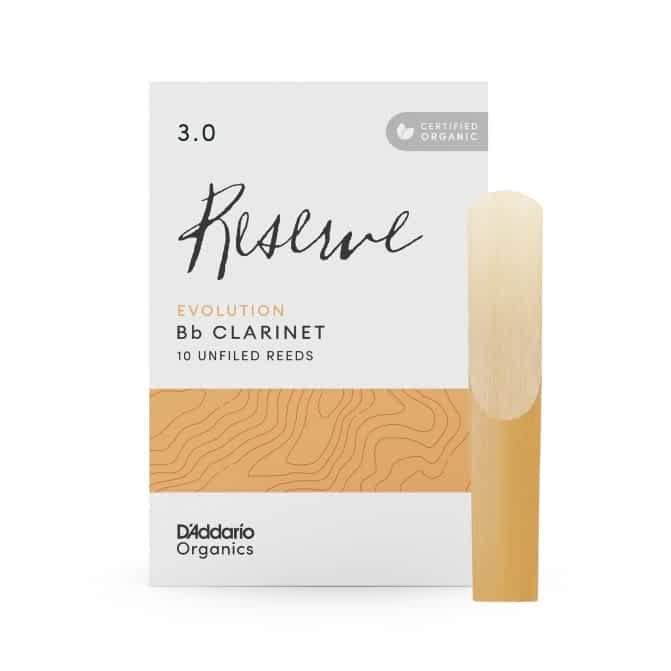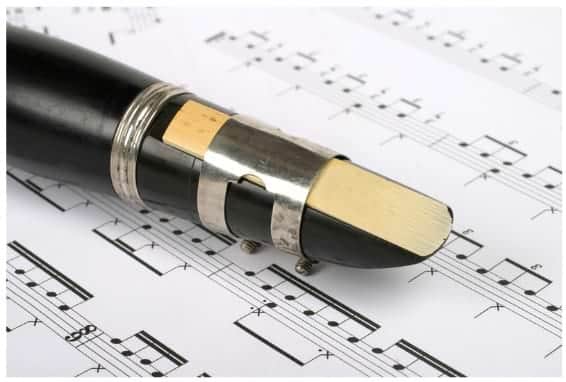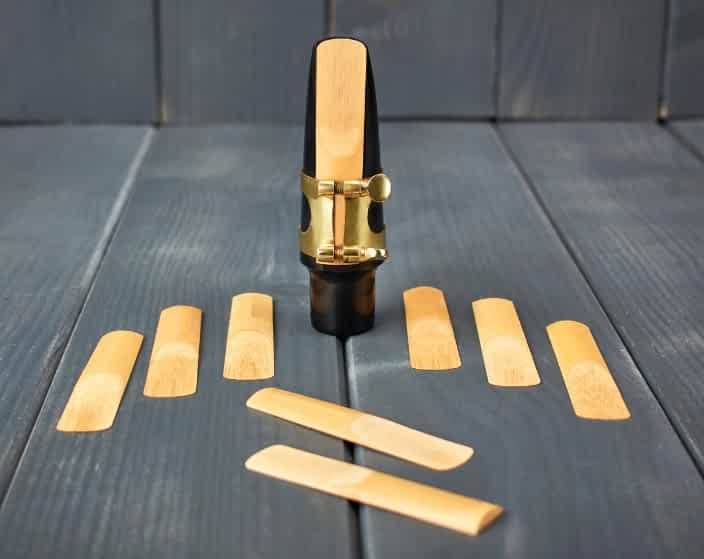Best
Overall Reed
Classical and Jazz
-
Overall: The Rico cut that is unfiled with a thinner profile
-
Best Feature: Thin Blank Type
-
TedScore™: 9/10
Best
Long Lasting Reed
-
Overall: Long-lasting and durable reed that comes with a six-month guarantee
-
Best Feature: Legacy clarinet reed tip size and thicker heart and vamp
-
TedScore™: 8.5/10
Best
Reed For Beginners
-
Overall: A reed tip that's specially Designed for New Players
-
Best Feature: USP is Long Lasting with No Wearing In Required
-
TedScore™: 9/10
Starting on the clarinet feels like a grand adventure, and picking the right beginner clarinet reeds is key to making lovely sounds straight away. I remember my first tries, feeling unsure but keen to make beautiful music, quickly noticing how much the reed mattered for clear notes.
Choosing the best reeds for clarinet can seem overwhelming, with options ranging from beginner-friendly to professional-grade.
But don’t worry; I’m here to help you navigate the choices so you can select a reed that will bring out the best in your clarinet playing. So, chin up, embouchure ready, and let’s begin mastering the clarinet together!
Best Rated Clarinet Reed Reviews

DESIGNED FOR: both classical and jazz applications
FEATURES: The Rico cut that is unfiled with thinner profile
OTHER INFO: Blank Type: Thin / Filing: Unfiled
1. Rico Reeds by D'Addario
When you check the price above, you’ll see there are loads of great places to buy this item. Our personal favorite is Gear4music.
It is the largest music retailer in the UK and fast becoming the most respected online music shop in the US too. Their customer service is excellent, they have competitive prices, really fast shipping, and usually have the longest guarantee.
Most professional musicians use Gear4music, so there is no reason why you shouldn’t too!
- Affordable price and ideal for students
- None
The professional musician who wrote this article combined many things,
from the product build, manufacturer’s reputation through to feedback
from other users, to create our famous TedScore™.

DESIGNED FOR: Intermediate Players
FEATURES: Ambipolymer synthetic reed
OTHER INFO: Tip Size: Legacy clarinet reed tip size / Vamp: Thicker heart and vamp
2. Silverstein Primo Bb Clarinet Reeds
When you check the price above, you’ll see there are loads of great places to buy this item. Our personal favorite is Gear4music.
It is the largest music retailer in the UK and fast becoming the most respected online music shop in the US too. Their customer service is excellent, they have competitive prices, really fast shipping, and usually have the longest guarantee.
Most professional musicians use Gear4music, so there is no reason why you shouldn’t too!
- Long-lasting and durable reed that comes with a six-month guarantee
- Can be clipped and sanded just like a cane reed
- Six-month guarantee is amazing
- Not as nice a sound as a cane reed
The professional musician who wrote this article combined many things,
from the product build, manufacturer’s reputation through to feedback
from other users, to create our famous TedScore™.

DESIGNED FOR: classical and jazz styles
FEATURES: Premium cane quality for long-lasting durability
OTHER INFO: Blank Type: Traditional / Filing: Filed
3. D'Addario Organic Reserve Evolution Bb Clarinet Reeds
When you check the price above, you’ll see there are loads of great places to buy this item. Our personal favorite is Gear4music.
It is the largest music retailer in the UK and fast becoming the most respected online music shop in the US too. Their customer service is excellent, they have competitive prices, really fast shipping, and usually have the longest guarantee.
Most professional musicians use Gear4music, so there is no reason why you shouldn’t too!
- Traditional tip for a versatile playability
- Great sound quality and excellent response
- Should last a decent length of time due to the filed cut
- Not as nice sounding as some other reeds
The professional musician who wrote this article combined many things,
from the product build, manufacturer’s reputation through to feedback
from other users, to create our famous TedScore™.

DESIGNED WITH: Thicker Natural Cane
FEATURES: A thicker reed tip with a heel taper very similar to German style reeds
OTHER INFO: Greater Stability
4. Vandoren 56 Rue Lepic Clarinet Reed
When you check the price above, you’ll see there are loads of great places to buy this item. Our personal favorite is Gear4music.
It is the largest music retailer in the UK and fast becoming the most respected online music shop in the US too. Their customer service is excellent, they have competitive prices, really fast shipping, and usually have the longest guarantee.
Most professional musicians use Gear4music, so there is no reason why you shouldn’t too!
- Strength gradations are smaller and more specific, resulting in reeds that are very consistent.
- Gives an extremely pure sound
- Sometimes a little tricky to play on
The professional musician who wrote this article combined many things,
from the product build, manufacturer’s reputation through to feedback
from other users, to create our famous TedScore™.

DESIGNED FOR: New Players
FEATURES: A softer reed tip. Long Lasting with No Wearing In Required
OTHER INFO: Extra Responsive
5. Juno by Vandoren Clarinet Reeds
When you check the price above, you’ll see there are loads of great places to buy this item. Our personal favorite is Gear4music.
It is the largest music retailer in the UK and fast becoming the most respected online music shop in the US too. Their customer service is excellent, they have competitive prices, really fast shipping, and usually have the longest guarantee.
Most professional musicians use Gear4music, so there is no reason why you shouldn’t too!
- Comes in Individual Humidity Balanced Packs
- Aids Development of Tone and Technique
- At some point, your embouchure muscles will grow out of them and need to get used to harder reeds
The professional musician who wrote this article combined many things,
from the product build, manufacturer’s reputation through to feedback
from other users, to create our famous TedScore™.
How to Choose a Clarinet Reed Buying Guide
The best clarinet reed for beginners will have a softer strength and is easier to blow.
Clarinet reeds for beginners tend to be thinner, so they’re easier on your lips and don’t require as much air pressure to play.
Choosing reeds made from quality materials like cane or synthetic materials that will last longer and provide a consistent sound is also essential.

Another factor to consider when selecting good clarinet reeds is the size of your mouthpiece. But how do you know what size reed for clarinet is perfect for you? Most beginners should start with a medium-strength 2 1/2 or 3 reed size, but it’s always best to consult your teacher before purchasing.
Finally, remember that the best way for clarinet players (beginner or advanced) to get the most out of their instrument is by using high-quality reeds that fit their playing style and mouthpiece size. With some experimentation, you can find suitable clarinet reeds for your needs!
Factors to Consider When Choosing a Clarinet Reed
The first step is to find the right strength. Clarinet reeds come in 1 through 5 strengths, with 1 being the softest and 5 being the hardest. Generally speaking, beginners will want to start with a 2 or 2.5 strength reed, while more advanced players may prefer something softer or harder.
The next step is to select a brand. While there are dozens of reed brands for clarinet available on the market today, some are more popular than others. Some of the best reed brands for clarinet include Vandoren, Rico Royal, and Legere Reeds. Each brand has its own unique rich sound and feel so it’s important to try out several different brands before settling on one that works for you.
Material: There are two main types of materials used for clarinet reeds: Synthetic and cane (natural). Synthetic reeds tend to be cheaper but don’t last as long as cane reeds; whereas cane reeds cost more but are much more durable.
Finally, consider how long each reed will last before needing to be replaced. Generally speaking, higher-quality clarinet reeds last longer than cheaper ones, but they also cost more upfront.
Reed Anatomy
Clarinet reeds are an essential part of the clarinet-playing experience. They come in all shapes and sizes, and understanding their anatomy can help you choose the best reed for clarinet that suits your playing style and needs.

The anatomy of a clarinet reed consists of four main parts: the back, heart, tip, and spine.
- The back of a clarinet reed is the thicker side that wraps around the heart and produces a fuller sound.
- The heart is where most of the action happens, vibrating to produce sound when blown into.
- The tip is where air passes through and produces vibrations that create sound waves.
- The spine provides stability to prevent warping or bending while playing.
It’s important to remember that different reeds produce different sounds depending on their shape and size, so experiment with various options before settling on one type of reed.
Knowing more about how each part works can help you make an informed decision when selecting your new clarinet reeds.
Reed Strength
When choosing a reed strength, it’s essential to understand its effect on your sound.
The stronger the reed, the more resistance you’ll feel when playing; therefore, your sound will be louder. However, this can also lead to an overly bright tone if it’s too strong for your skill level.
On the other hand, softer reeds offer less resistance and are easier to control but can produce a softer tone that lacks character.
Choose the Right Reed Cut
The reed cut affects your instrument’s sound, intonation, and response. A good reed cut can help you get the most out of your instrument and make a huge difference in your playing.
A proper reed cut should be precise and consistent across all notes. This ensures that it produces a clear tone with minimal effort, no buzzing or honking sounds, and maintains accurate intonation throughout the range of notes.
The ideal reed cut should also be tailored to the individual player’s embouchure and preference.

Best Clarinet Reed Brands
When it comes to purchasing clarinet reeds, there are many brands on the market. While some may be cheaper, they don’t always provide the best quality and sound. To ensure you have a great playing experience with your clarinet, here are some of the best brands for clarinet reeds:
1. Vandoren – Vandoren reeds is one of the world’s most popular brands for clarinet reeds, providing a wide range of strength and cut options to suit all players.
2. D’Addario – D’Addario Bb Clarinet Reeds are another well-known brand, offering great value for money and good longevity with their reeds.
3. Rigotti – Rigotti offers a selection of premium quality reeds that can last up to four times longer than other brands. They also produce a variety of strengths so you can find what suits your playing style best.
4. Rico Reeds – Rico Bb Clarinet Reeds are an affordable choice if you’re looking for good sound without breaking the bank! Their reed range is designed to offer players increased response and easy playability at an economical price point.
When to Replace Your Clarinet Reed?
All clarinet players should inspect their reed for any signs of wear and tear. If you see any cracks or chips, then it may be time to replace your reed.
In addition, if you notice that your reed has become too soft or too hard, then it’s definitely time for a new one.
Finally, if you’ve been playing on the same reed for more than six months without any major changes in its condition, then it’s probably time to replace it as well.

Caring for Your Reeds
Caring for your clarinet reeds is essential if you want to achieve a sweet sound and extend the life of your reeds. Here are some tips on how to properly care for them, written by some fantastic most clarinet teachers we know:
- Always moisten your reed before playing – this helps activate the cane fibers and improves flexibility
- Keep your reed away from direct sunlight – this will help prevent warping and cracking, which can affect the way it vibrates when played
- Don’t leave your reed out of its case for too long – prolonged exposure to air can cause it to dry out quickly, so make sure you store it in an airtight container when not in use
- Clean your reed regularly – clean off any dirt or dust that could affect its sound quality with a soft cloth or brush after each use; this also helps keep mold at bay!
- Rotate between two or three reeds – having multiple reeds ensures that you always have one that is ready when needed; using multiple helps them last longer
Best clarinet reeds for beginners
Summary
Choosing the best clarinet reed for beginners can be quite the adventure that sets the tone (quite literally) for your musical journey.
I’ve sifted through the noise and found that a size 2 or 2.5 reed is your best mate when starting. They’re softer, so they’re kinder to your fingers and make getting that beautiful sound feel effortless.
If you fancy the Vandoren CR101 Bb Clarinet Reeds, you’re in for a treat. Their reputation for responsiveness is well-deserved, and they’ll help you hit those high notes with finesse. The D’Addario Royal 2.5 strength reeds also shine for producing clear, brilliant sounds, perfect for a beginner’s blossoming repertoire.
Whether you’re a beginner or a professional, choosing from these trusted brands ensures optimal playability and sound. With a great selection of reeds in your arsenal, you will be able to enjoy playing the clarinet for many years to come!
And before you go – have you seen our new article ‘How To Clean Clarinet Mouthpiece‘?
FAQ's
The size of a clarinet reed can vary depending on the player’s preference and skill level, but beginners generally start with a size 2 or 2.5 reed, while more experienced players may use sizes ranging from 3 to 5.
When choosing a clarinet reed, the material can also be a factor to consider. Synthetic reeds are known for their consistency and durability, while cane reeds are preferred by many players for their natural sound and responsiveness.
Professional clarinetists typically use reed sizes ranging from 3 to 5, depending on their personal preference and playing style. The specific size of reed used can also vary depending on the type of music being played.
Benny Goodman played a Selmer clarinet throughout his career, specifically a Selmer Model 26.
Popular and highly regarded clarinet reed brands include Vandoren, D’Addario, Rico, and Legere, which are known for offering a range of reed strengths and cuts to cater to different playing preferences. Clarinet players must experiment with various reed options to find the best match for their playing needs.











In regards to reed strength, it seems a bit oversimplified in the article. The impact of humidity and temperature on reed performance is significant and should be discussed in more depth. Can anyone share their methods for adjusting reed playability under varying climatic conditions?
Bill_the_Critic, excellent point. Adjusting for humidity involves using a reed case with humidity control for starters. Some players even alternate between different reeds to match the day’s conditions. It’s quite the art.
reading about reed anatomy, am i in a biology class now? lol
This guide is really comprehensive, especially the section on reed strength. It’s crucial to match your reed’s strength with your mouthpiece and playing ability. I’ve seen too many students pick up a strength that’s too high for them, thinking it’ll make them sound better, but it only hampers their progress. Also, shoutout to Bethan Greenaway, your guides are a lifesaver for us music students!
Hey, anyone knows if the reeds for beginners part, talks about how tough these are? Starting out and I break stuff a lot. Thanks!
AlexT, beginner reeds are generally more forgiving and durable. Don’t sweat it, we’ve all been there!